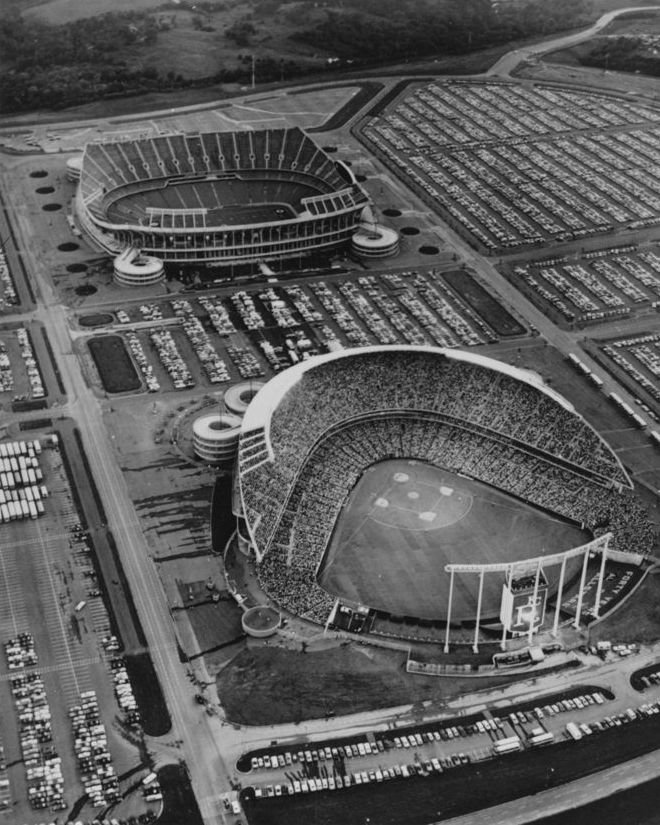The Story of Truman Sports Complex: Home of Arrowhead & Kauffman
Courtesy: Missouri Valley Special Collections, Kansas City Public Library, Kansas City, MO
At the crossroads of Interstate 70 and Interstate 435, the Truman Sports Complex has long stood as a prominent landmark in Kansas City, home to two iconic sports venues: Arrowhead Stadium and Kauffman Stadium.
These stadiums have played a central role in the city’s sporting culture, representing decades of professional football and baseball while drawing fans from across the region.
The Vision for a Sports Hub
The original plans called for a rolling roof to be shared by the two venues. Courtesy: JCHS
In the 1960s, the growing interest in professional sports led to the development of the Truman Sports Complex. The move of the Dallas Texans to Kansas City in 1963 (becoming the Chiefs) helped accelerate the need for a modern sports facility. After voters approved a $102 million bond in 1967, plans for a complex featuring two stadiums were set in motion.
Architect Charles Deaton’s initial design included a rolling roof that would cover both Arrowhead and Kauffman Stadiums, providing protection from Kansas City’s variable weather. However, due to cost and complexity, the rolling roof feature was ultimately not implemented, leaving the stadiums uncovered but still distinctive in design.
Arrowhead Stadium: A Football Fortress
Courtesy: Missouri Valley Special Collections, Kansas City Public Library, Kansas City, MO
Opening in 1972, Arrowhead Stadium quickly earned its place as one of the most iconic venues in professional football. Designed by local architectural firm Kivett & Myers, its forward-thinking design set a new standard for sports arenas.
Arrowhead's layout was created with fans in mind, offering steep, multi-tiered seating that brings spectators closer to the field, ensuring great views from every angle. This innovative design also had the effect of amplifying crowd noise, which has contributed to Arrowhead’s reputation as one of the loudest stadiums in the NFL. In fact, it holds the Guinness World Record for the loudest crowd roar at 142.2 decibels, set during a 2013 game against the New England Patriots.
One of the stadium’s distinctive features is its brutalist, no-frills design, characterized by its prominent use of exposed concrete, typical of sports venues built in the 1960s and 70s. The atmosphere created by the Chiefs Kingdom gives Arrowhead one of the most strongest home-field advantages in the league.
Arrowhead’s history is filled with unforgettable moments, from hosting the Chiefs' first regular-season victory in 1972 to witnessing the team’s recent resurgence and Super Bowl triumphs. The stadium is not just a hub for NFL games but is set to host matches in the 2026 FIFA World Cup, adding to its international prestige.
While the Chiefs organization is considering future options for either further renovations or potentially building a new stadium, for now, Arrowhead remains a beloved icon and an enduring part of Kansas City's identity, representing the city's passion for football.
Kauffman Stadium: Where Baseball Dreams Soar
1973: Aerial view of Royals Stadium during All-Star game. Courtesy: Missouri Valley Special Collections, Kansas City Public Library, Kansas City, MO
Opening in 1973, Kauffman Stadium quickly became one of Major League Baseball’s premier ballparks. Unlike many stadiums of its era, Kauffman was built solely for baseball, creating a unique experience for fans and players alike. While multi-purpose venues were common at the time (see Oakland, Atlanta, Houston, etc), Kauffman’s baseball-centric design crafted an intimate atmosphere where fans are close to the action.
The stadium’s most distinctive feature is its outfield fountains, paying homage to Kansas City's title as the "City of Fountains." These water features provide a serene contrast to the excitement of the game, making Kauffman one of the league’s most visually unique stadiums. Its circular design and unobstructed sightlines offer an immersive viewing experience.
Kauffman has hosted many memorable moments, from George Brett’s career highlights to the Royals’ World Series victories in 1985 and 2015.
Over the years, Kauffman has undergone renovations to maintain its status as a top-tier baseball venue, from modern seating to cutting-edge scoreboards. Despite these updates, the stadium has preserved its original charm, making it a favorite for both purists and casual fans.
The Unfulfilled Dream: The 2008 Bond Issue
Courtesy: Missouri Valley Special Collections, Kansas City Public Library, Kansas City, MO
The idea of adding a rolling roof to the complex has persisted throughout the years. In 2006, voters approved a tax increase for significant renovations, but the additional funding required to implement the rolling roof was not secured. While the roof concept remains a part of the complex’s history, the stadiums have continued to evolve without it.
Looking ahead, discussions about the future of the Truman Sports Complex are ongoing, with the leases for both Arrowhead and Kauffman set to expire in 2031. The Royals' ownership continues to explore the possibility of moving to a downtown ballpark, while the Chiefs are considering future renovations to Arrowhead or a new stadium altogether.
Regardless of the future, these venues have provided generations of memories and stand as enduring symbols of the city’s connection to its teams and sports culture.




